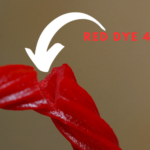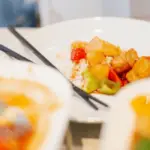Today you will learn how root beer gets its color. We specifically tell you if red dye is used or a different color additive. Let’s get into the details of what makes root beer dark brown in color!
Red Dye In Root Beer?
You can determine if a root beer has red dye by looking at its ingredients. The Food and Drug Administration (FDA) requires that beverage manufacturers disclose man-made (synthetic) and naturally sourced dyes in the ingredients.
Synthetic dyes used in foods and beverages must be certified by the FDA after each batch is made and will appear in the ingredients under their certified name such as Red 40. Dyes that come from natural sources typically appear in the ingredients under more general terms such as “colored with fruit juice”.
Of the 16 root beer brands featured below, none of them contain red dye. It is uncommon for root beer to be colored with red dye.
Rather, root beer gets its color from caramel color, which is in nearly all root beers below. Caramel color is a popular color additive used in sodas. It is typically made by heating corn syrup with a reactant such as salt, acid, or alkali to start the caramelization process. Caramel color can be found in Coke, Pepsi, Dr Pepper, and many other dark brown sodas.
| Root Beer | Red Dye (Yes or No)? | Ingredients |
|---|---|---|
| A&W | No | Carbonated Water, High Fructose Corn Syrup, Caramel Color, Sodium Benzoate (Preservative), Natural And Artificial Flavors, Quillaia Extract |
| Barq’s | No | Carbonated Water, High Fructose Corn Syrup, Caramel Color, Sodium Benzoate (To Protect Taste), Citric Acid, Caffeine, Artificial And Natural Flavors, Acacia. |
| Mug | No | Carbonated Water, High Fructose Corn Syrup, Caramel Color, Sodium Benzoate (Preserves Freshness), Citric Acid, Natural And Artificial Flavor. Calcium Disodium EDTA (To Protect Flavor). Quillaia Extract. |
| IBC | No | Carbonated Water, Sugar, Caramel Color, Sodium Benzoate (Preservative), Natural And Artificial Flavors, Modified Corn Starch, Citric Acid. |
| Stubborn | No | Carbonated Water, Sugar, Caramel Color, Natural Flavor, Sodium Benzoate (Preserves Freshness), Phosphoric Acid, Citric Acid, Calcium Disodium EDTA (To Protect Flavor). |
| Stewart’s | No | Carbonated Water, Cane Sugar, Caramel Color, Sodium Benzoate (Preservative), Natural and Artificial Flavors, Citric Acid, Quillaia Extract, Acacia Gum, Yucca Extract. |
| Boylan Bottling | No | Carbonated Water, Cane Sugar, Natural and Artificial Flavors, Caramel Color, Sodium Benzoate (Preserves Freshness), Citric Acid. |
| Henry Weinhard’s | No | Carbonated Water, Cane Sugar, Natural and Artificial Flavors (Caramel Color, Acacia Gum, Potassium Sorbate (Preservative)), Sodium Benzoate (preserves freshness), Phosphoric Acid |
| Virgil’s | No | Sparkling Filtered Water, Sweetener Blend (Erythritol, Stevia Leaf Extract), Natural Flavors, Caramel Color, Citric Acid. |
| Sprecher | No | Carbonated Water, Glucose Syrup, Maltodextrin, Raw WI Honey, Natural & Artificial Flavors, Sodium Benzoate (As A Preservative), Phosphoric Acid, Quillaia/Yucca Extract, Sodium Chloride, Natural Caramel Color. |
| Zevia | No | Carbonated Water, Stevia Leaf Extract, Natural Flavors, Citric Acid. |
| Bundaberg | No | Carbonated Water, Cane Sugar, Root Beer Brew (Water, Sugar, Molasses, Ginger Root, Sarsaparilla Root, Licorice Root Extract, Vanilla Bean Extract, Yeast), Caramel Color, Citric Acid, Preservatives (Potassium Sorbate, Sodium Benzoate), Antioxidant (Ascorbic Acid), Root Beer Flavor. |
| Shasta | No | Carbonated Water, High Fructose Corns Syrup, Caramel Color, Potassium Benzoate (Preservative), Natural and Artificial Flavors, Sucralose. |
| Faygo | No | Carbonated Water, High Fructose Corn Syrup, Caramel Color, Potassium Benzoate (Preservative), Natural and Artificial Flavors, Citric Acid, Sucralose, Potassium Sorbate (Preservative). |
| Great Value | No | Carbonated Water, High Fructose Corn Syrup, Caramel Color, Potassium Benzoate (a preservative), Natural and Artificial Flavor |
| Big K | No | Carbonated Water, High Fructose Corn Syrup, Caramel Color, Sodium Benzoate (Preservative), Citric Acid, Modified Corn Starch, Natural And Artificial Flavors. |
Caramel Color Is Safe?
Caramel color has been used in foods and beverages for over a century and a half. Additionally, it is currently approved as a color additive by the FDA and other global health organizations such as the European Food Safety Authority (EFSA).
However, there has been some concern with caramel color because of a byproduct that is sometimes produced during its cooking process. The byproduct is known as 4-Methylimidizole (4-MEI).
A Study found that 4-MEI increased the occurrence of tumors in the lungs of mice. Furthermore, a different study revealed evidence of reproductive and developmental issues associated with rodents that were fed 4-MEI. However, in both of the studies, the rodents were given levels of 4-MEI that greatly exceeded the amount a human would commonly consume.
In summary, caramel color is currently deemed safe based on the levels that humans consume. You can eliminate it from your diet if you still have concerns about it. Caramel color is not an essential nutrient so removing it from your diet will not impact your health.
If you wish to avoid caramel color or potentially other ingredients, be sure to read the label at the store for the most accurate ingredient information.
Sources:
Vollmuth, Thomas. (2017). Caramel color safety – An update. Food and Chemical Toxicology. 111. 10.1016/j.fct.2017.12.004.







